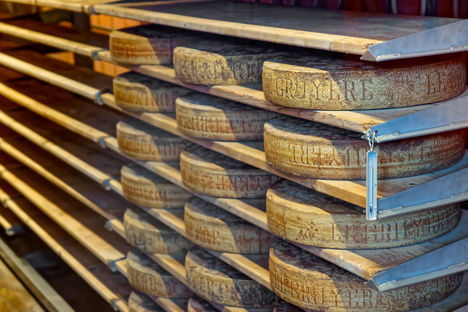
Le Gruyère AOP: a history
Switzerland’s favourite cheese has become a world-class favourite, and has a long, storied 900-year history behind it. Learn how the cheese got to where it is today and why its producers had to fight to protect its origins.
Le Gruyère AOP: a history
Switzerland’s favourite cheese has become a world-class favourite, and has a long, storied 900-year history behind it. Learn how the cheese got to where it is today and why its producers had to fight to protect its origins.
There are thousands of cheese varieties made across Europe, but only a handful become truly world-famous. The Italians have Parmesan; the French have Brie; the Spanish have Manchego and the British have cheddar. In Switzerland, it’s the firm, nutty, sweet, rich cheese known as Le Gruyère AOP that’s made it into the fromage hall of fame. And while anyone who’s tasted it will instantly understand why, a closer look at the history of this cheese proves even further just how special it is.
The first records of Gruyère date right back to medieval times – 1115 to be exact – when dairy farmers would make it to preserve their milk for times of need. It gets its name from the Swiss alpine town of Gruyères, where it first originated, which lies near the French border. The beautiful mountains and valleys around the town are where the cows roam and graze; the fresh air, sweet grasses and lush pastures make the milk particularly high quality, which in turn gives the cheese its incredible flavour.
Over time, Swiss Gruyère became the envy of cheesemakers across Europe. By the 1600s the cheese was officially named, marking its transition from a needs-must foodstuff for peasants into something the wealthy wanted to buy, and Gruyère began to be exported and traded across the continent. As it grew in popularity, there was an increase in cheesemakers trying to replicate the original recipe and pass their creations off as the real deal, which resulted in the word ‘Gruyère’ being added to the Académie Francaise in 1762.
This was still not enough to protect the traditional recipe of the cheese, however, and by the nineteenth century cheesemakers from outside the Canton of Freiburg (where the town of Gruyères is based) were producing their own versions of ‘Gruyère’. The French in particular were also making large amounts of their own style of Gruyère too – different because it had holes in, whereas the Swiss version is solid – and so the original Swiss cheesemakers began fighting for official recognition for their creation.
From 1890, the French and the Swiss argued and debated over who should be crowned the official creators of Gruyère cheese. Over the following 100 years, there were talks held in Madrid, Paris and Rome about products such as Gruyère cheese and how they could be protected from imitators. The result was the introduction of Protected Designation of Origin (PDO) status for some of Europe’s most famous foods, but it took a long time for Gruyère to get the official recognition it deserved. However, in 2001, it was awarded AOC protected status in Switzerland, which meant cheesemakers in the country had to make it following traditional methods.
This was a step in the right direction, but there was still work to be done. The French had also gained AOC protection for their own version of Gruyère (the one with holes in). This meant that there were two different cheeses being produced under the name Gruyère, which resulted in the original Swiss one being confused with the variety being produced in France. Both the French and Swiss Gruyère producers were vying for AOP protection – a step up from AOC which sees the cheese recognised by the EU, and therefore in both countries. The victor would walk away with the protection needed to sell their cheese as the ‘original’ Gruyère forever.
While it was the French who initially set out to claim the AOP as their own, the Swiss rightfully complained, pointing out that the cheese was named after one of their own towns and had been made in their country for a lot longer. The EU agreed, and in 2011 Switzerland’s Gruyère was given AOP status and became known as Le Gruyère AOP. While you’ll still find French-made Gruyère (and indeed, other countries have followed suit to create their own versions too), Switzerland can now officially say theirs is the original – and best.


